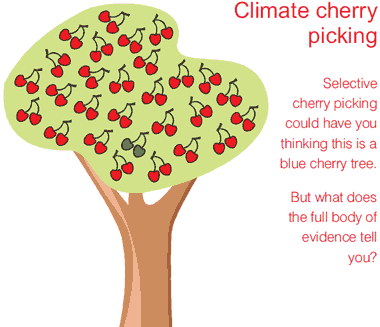How Suffolk County Community College students contributed to the Guide to Skepticism
Posted on 19 March 2011 by John Cook
![]() The Suffolk County Community College (SCCC) have just released a press release about how their students contributed to The Scientific Guide to Global Warming Skepticism. The idea for the Guide originally came from SCCC Professor, Scott Mandia, who also played an active part in putting together the content throughout the writing process. Part of this included showing an early draft of the Guide to his class, to obtain a layperson's perspective. Here's an excerpt from the press release (okay, it's the whole thing):
The Suffolk County Community College (SCCC) have just released a press release about how their students contributed to The Scientific Guide to Global Warming Skepticism. The idea for the Guide originally came from SCCC Professor, Scott Mandia, who also played an active part in putting together the content throughout the writing process. Part of this included showing an early draft of the Guide to his class, to obtain a layperson's perspective. Here's an excerpt from the press release (okay, it's the whole thing):
SUFFOLK COUNTY COMMUNITY COLLEGE STUDENTS CREDITED WITH CONTRIBUTING TO THE SCIENTIFIC GUIDE TO GLOBAL WARMING SKEPTICISM
Suffolk County Community College students in Professor Scott Mandia’s Meteorology 101, Introduction to Weather, class have been acknowledged for their contributions to the Scientific Guide to Global Warming Skepticism, published by John Cook of Skeptical Science. This document was recently released to the public and features the human fingerprints of global warming along with rebuttals of some of the more common skeptical arguments. The guide is well-illustrated and the text is written in an easy-to-read format. The names of the scientists that contributed to this document include top climate scientists in the field. The goal of the document is to further educate the public about global warming.
“SCCC students were instrumental in crafting this document. The students were asked to review the guide as an extra credit project and 23 students took advantage of this opportunity. Many of their comments were incorporated into the final version,” Mandia noted.
The Guide will be distributed to hundreds of thousands of people worldwide. More information including a download link can be found at Skeptical Science including a Support Forum for questions related to the Guide. To access the guide visit: https://skepticalscience.com/The-Scientific-Guide-to-Global-Warming-Skepticism.html. To access the support forum visit https://skepticalscience.com/topic.php?t=14.
Professor Mandia is a noted expert on global warming. He maintains a comprehensive website (www2.sunysuffolk.edu/mandias/global_warming/) and blog (profmandia.wordpress.com) with the mission of climate science education. Mandia has also published articles on the internationally acclaimed science blogs Realclimate.org and Climateprogress.org, among many others. More recently, he co-founded the Climate Science Rapid Response Team, www.climaterapidresponse.org, comprised of over 120 of the world’s top climate scientists. This endeavor has provided highly accurate science information to international media and federal and state lawmakers.
About Suffolk County Community College
Suffolk County Community College (SCCC) is the largest community college in the State University of New York (SUNY) system, enrolling approximately 25,000 students at its three campuses in Selden, Brentwood and Riverhead. SCCC offers the Associate in Arts (A.A.), Associate in Science (A.S.), and Associate in Applied Science (A.A.S.) degrees, as well as a variety of certificate programs. Offering the lowest college tuition on Long Island, a highly respected Honors program, extensive extracurricular activities, championship athletic teams, and numerous unified transfer programs, SCCC is a first-choice college for Long Island students. Visit us online at www.sunysuffolk.edu.
There were many great comments from the students. The strongest comment seemed to be an almost unanimous dislike of the graph in Human Fingerprint #1: The fossil fuel signature in the air and coral. Originally I used this graph:

Figure 1: Changes in d13C (ratio of C13 to C12) for corals from Atlantic and Pacific/India Oceans compared to sclerosponge and atmospheric measurements (Swart et al 2010).
Now I love this graph. It tells us that CO2 from fossil fuel burning is building up both in the atmosphere, in corals from different oceans and in sea sponges. Multiple lines of evidence all pointing to a human fingerprint in CO2 levels. But like I'm always telling those who write for Skeptical Science, peer-reviewed figures try to cram as much info as possible into a single graph while figures for the general public need to be as simple as possible. So taking my own advice, I went with a much simpler graph.
The graphic that got the most rave reviews was, to my puzzlement, the cherry tree on Page 1:

What?! It's just a tree, people! How could a tree trump the cool graph of Total Heat Content or the telling room full of climate scientists? Well, apparently it does. At first, my private suspicion was perhaps the students were trying to curry the favour of their professor who suggested the idea of using the cherry tree. But then I attended a climate change communication workshop hosted by the Bureau of Meterology. A woman came up to me, said she had just read the Guide and loved the tree! Okay, cherry tree, you win this round!
Anyway, having the SCCC students proofread the Guide was quite an instructive experience. It reinforced some basic principles of communicating climate science to a lay audience (that I already knew but had chosen to ignore). Many thanks to the students and to Scott Mandia for making this all happen.
UPDATE: I've already received a request to reuse the cherry tree so I've added a high-rez and vector version of the cherry tree (under a creative commons license so everyone is free to use it) to the Climate Graphics page. That blasted tree wins another round!
Note: if you want to tell people about the Guide (please do share it around), the short URL is http://sks.to/guide































 Arguments
Arguments






























I'll take the speech bubble idea under advisement :-)
Don't worry, I wasn't planning to use the speech bubbles (no offense, Albatross, I hope :-)